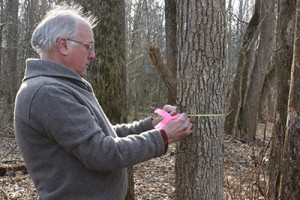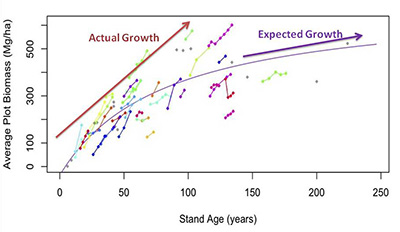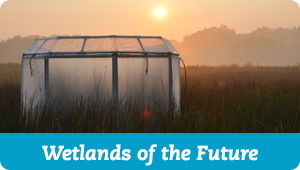 Every time Earth’s climate changes, there are winners and losers. One of the winners—at least in the short-term—may be trees. After tracking their growth for 25 years, Dr. Jess Parker made a startling discovery: Trees in Maryland forests have actually grown two to four times faster in the last 22 years than they have in the last 225 years.
Every time Earth’s climate changes, there are winners and losers. One of the winners—at least in the short-term—may be trees. After tracking their growth for 25 years, Dr. Jess Parker made a startling discovery: Trees in Maryland forests have actually grown two to four times faster in the last 22 years than they have in the last 225 years.
While they’re still pinning down the exact cause, the signs so far point to climate change. Trees use CO2 to photosynthesize and create food. There’s more CO2 in the atmosphere now than there has been for 3 million years. Spiked CO2 levels, combined with warmer temperatures and longer growing seasons, appear to have sent the trees into a binge phase, leading them to put on more weight in less time.

Jess Parker measures tree growth using a dendrometer, a metal band that expands as a tree widens.
Parker’s lab didn’t have records to tell them how quickly trees had grown in past centuries. But they did know the ages of the trees inside SERC’s forest. The tree stands they measured ranged from five to 225 years old. From there, they could calculate how quickly the trees would have needed to grow to reach their sizes today. Much like people, younger trees tended to grow faster; old age slowed them down.
But once the ecologists began measuring their current rate of growth—a project Parker began in 1987—the situation changed. His team of scientists and volunteers measured roughly 50,000 trees over a quarter century. The trees’ actual growth over those 22 years was much higher than it should have been if the trees had maintained their earlier speed. On average, they found the forest gained about two tons more per acre annually. Parker knew the trees couldn’t have been growing that quickly their entire lives; otherwise they would be much larger.
To ecologists, this is a fragment of good news in the largely grim portrait of climate change. Forests are one of nature’s most critical carbon sinks. By soaking CO2 out of the atmosphere, they help cushion us against its more harmful effects. If forests are growing faster now, they could not be doing it at a more urgent time.
However, there are still unanswered questions. Since ecologists only began taking real-time measurements in 1987, they don’t know exactly when the growth spurt began or how long it will last. Nor are they sure what all this extra activity could mean for other parts of the forest.
Meanwhile, the years of plenty may not last. Warmer temperatures and higher CO2 are not the only elements at work under climate change. Less water—a resource that may decrease with the loss of winter snowmelt—could slow down the tree’s growth. And while a forest’s capacity to store carbon is large, it is not unlimited. Parker doubts the trees will be able to maintain this grueling pace indefinitely. At some point their growth will level off. If CO2 levels are still rising when they do, the forests eventually will become saturated.
Learn more!
Discover how SERC scientists research the canopy in the Forest Ecology Lab.



 Find out more. Learn how climate change will impact the world from the
Find out more. Learn how climate change will impact the world from the 

